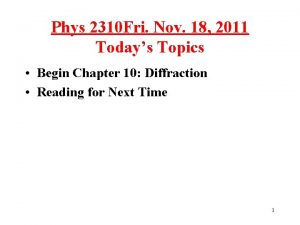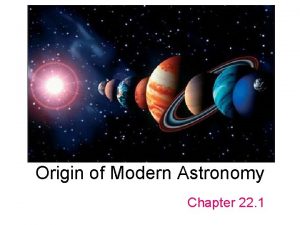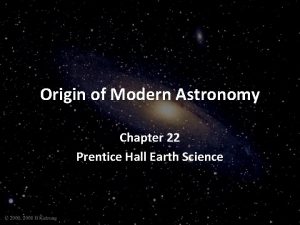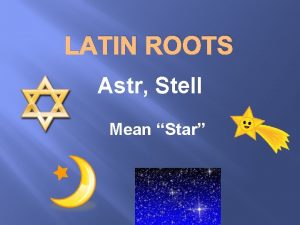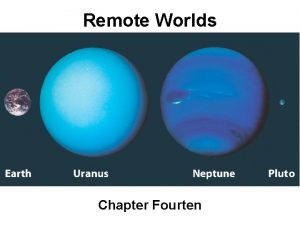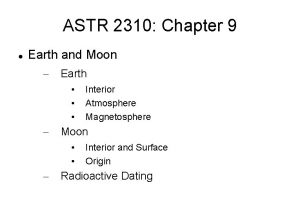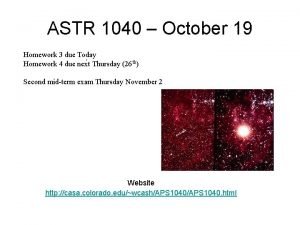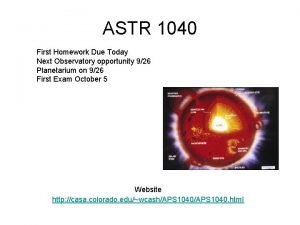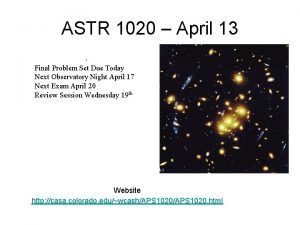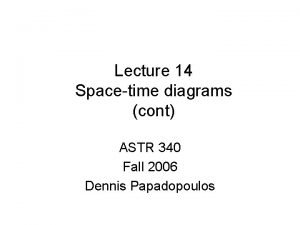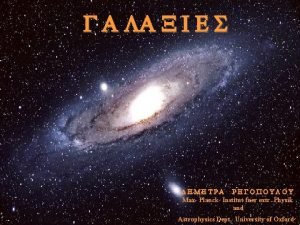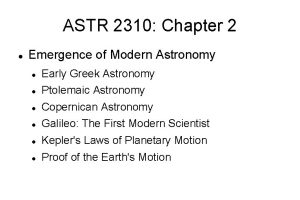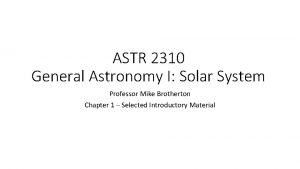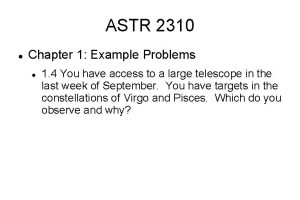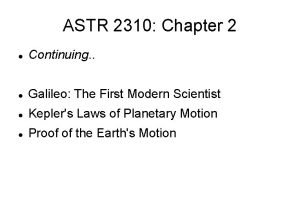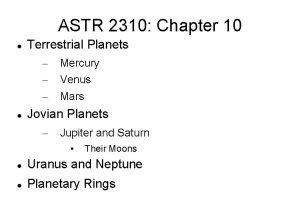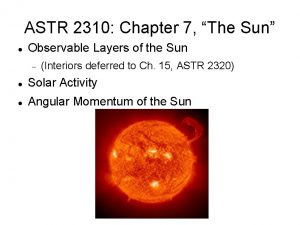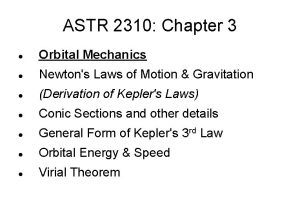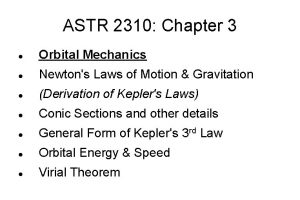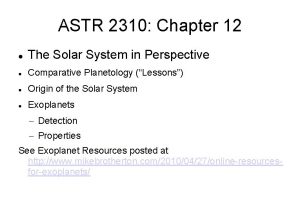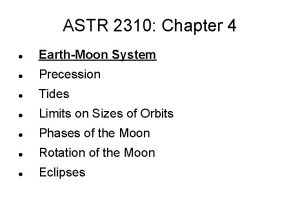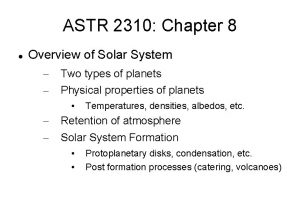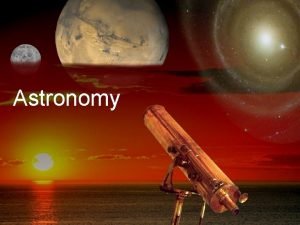ASTR 2310 Chapter 2 Emergence of Modern Astronomy






















- Slides: 22

ASTR 2310: Chapter 2 Emergence of Modern Astronomy Early Greek Astronomy Ptolemaic Astronomy Copernican Astronomy Galileo: The First Modern Scientist Kepler's Laws of Planetary Motion Proof of the Earth's Motion

ASTR 2310: Chapter 2 Early Greek Astronomy Smart, but limited experimentation Limited tools (e. g. no telescopes) Our knowledge is fragmentary Still lots of stuff right way back then E. g. , Lunar phases and eclipses more as well

ASTR 2310: Chapter 2 Aristotle's Explanations for Spherical Earth Gravity pulls everything together, strongly, and a sphere is the most compact form Partial lunar eclipses always show an arc of a circle and only spheres ALWAYS show such shadows from any angle Different stars visible as you move south, suggesting a curved Earth. African and Indian elephants similar and on “opposite sides of the world” so they must be close to each other. . . well, not quite!

ASTR 2310: Chapter 2 Aristarchus: Relative Distances to Sun and Moon Wikipedia: http: //en. wikipedia. org/wiki/Aristarchus_On_the_Sizes_and_Distances

ASTR 2310: Chapter 2 Aristarchus: Relative Distances to Sun and Moon A/C=cosine theta. Theta=87 degrees means C=19 A If theta =89. 853 degrees (modern value) then C=390 A

ASTR 2310: Chapter 2 Aristarchus: Relative Sizes of Moon, Earth, Sun Geometry involving eclipses Wiki: http: //en. wikipedia. org/wiki/Aristarchus_On_the_Sizes_and_Dista nces#Lunar_eclipse Came up with 1: 3: 19 (modern values 1: 4: 390) for ratios of diameters.

ASTR 2310: Chapter 2 Eratosthenes: Size of the Earth Geometry involving the sun Wiki: http: //en. wikipedia. org/wiki/Eratosthenes Figured out what fraction (1/50) of the Earth's circumference corresponded to the distance between Alexandria and Syene Figure from Wired Magazine Theta is about 7 degrees Answer is the circumference is 46, 000 km Modern value closer to 40, 000 km

ASTR 2310: Chapter 2 Hipparchus: Extraordinary Observer Star Catalog Led to detection of precession of equinoxes Magnitude system (ASTR 2320 horror show!) Accurate distance to the Moon (not too far off the modern value of 60. 5 Earth radii) Length of tropical year (good to 7 minutes)

ASTR 2310: Chapter 2 Emergence of Modern Astronomy Early Greek Astronomy Ptolemaic Astronomy Copernican Astronomy Galileo: The First Modern Scientist Kepler's Laws of Planetary Motion Proof of the Earth's Motion

ASTR 2310: Chapter 2 Ptolemaic Astronomy Ptolemy developed detailed mathematical model to predict positions of objects in the sky Used for 14 centuries Accurate but conceptually flawed

ASTR 2310: Chapter 2 Ptolemaic Astronomy Observed elements: • Stars, with fixed relative positions, rotate around celestial pole • Sun moves east along ecliptic, tilted at 23. 5 degrees, about 1 degree per day • Moon moves east also, not quite on ecliptic, about 13 degrees per day • Planets usually move eastward (prograde), but sometimes west (retrograde). And only some planets.

ASTR 2310: Chapter 2 Ptolemaic Astronomy Earth doesn't move (no sense of motion, parallax) Not quite at center Everything “circles” Lots of weird terms Predicts positions ok!

ASTR 2310: Chapter 2 Ptolemaic Astronomy Not all planets equal! Placements look odd Tested by Galileo

ASTR 2310: Chapter 2 Copernican Astronomy Sun at center -- heliocentric Still circles Simpler Not more predictive

ASTR 2310: Chapter 2 Copernican Astronomy Explanation for retrograde motion

ASTR 2310: Chapter 2 Copernican Astronomy Inferior Planets no retrograde motion always close to the sun orbits smaller than Earth's • Venus, Mercury Superior Planets (Mars, Jupiter, Saturn known by Greeks) • Retrograde motion, orbits larger than Earth's

ASTR 2310: Chapter 2 Copernican Astronomy More Terminology – draw Figure on board • • • Opposition Conjunction Quadratures Elongation (angle between planet and sun) Synodic period (e. g. , time between conjunctions) Sidereal period (period relative to background stars)

ASTR 2310: Chapter 2 Copernican Astronomy – Inferior Planets Orbital Periods and Relative Planetary Distances Angular Velocities (w) Inferior Planets: w. P = w. E + wsyn (w. P > w. E) Inferior Planets: 1/PP = 1/PE + 1/Psyn Period of Venus: (1/365. 26 days + 1/583. 92 days)-1 So we get the orbital period of 224. 70 days

ASTR 2310: Chapter 2 Copernican Astronomy – Superior Planets Orbital Periods and Relative Planetary Distances Angular Velocities (w) Superior Planets: w. P = w. E - wsyn (w. P < w. E) Superior Planets: 1/PP = 1/PE - 1/Psyn Period of Mars: (1/365. 256 days - 1/779. 95 days)-1 So we get the orbital period of 686. 98 days

ASTR 2310: Chapter 2 Copernican Astronomy – Planetary Distances Relative to Earth-Sun Distance (Astronomical Unit) See nice webpage at: • http: //astro. unl. edu/naap/ssm_advanced. html

ASTR 2310: Chapter 2 Copernican Astronomy Inferior Planet Orbital Distances (assume circular) D = 1 Astronomical Unit (1 AU): So d = sin q in AU

ASTR 2310: Chapter 2 Copernican Astronomy Superior Planet Orbital Distances Time t from position 1 to 2 Angle a = t (360/PE) Angle b = t (360/PP) So d = 1/(cos(a-b)) Again in AU
 Learning astronomy by doing astronomy
Learning astronomy by doing astronomy Learning astronomy by doing astronomy activity 7 answers
Learning astronomy by doing astronomy activity 7 answers Learning astronomy by doing astronomy activity 1 answers
Learning astronomy by doing astronomy activity 1 answers 45(oktal) = … (desimal)
45(oktal) = … (desimal) 2310
2310 Konersi
Konersi Chapter 22 origin of modern astronomy answer key
Chapter 22 origin of modern astronomy answer key Tycho brahe believed that
Tycho brahe believed that Astr greek or latin
Astr greek or latin Trans neptunian objects
Trans neptunian objects Greek or latin root/affix ortho
Greek or latin root/affix ortho Astr
Astr Astr
Astr Homework due today
Homework due today Astr
Astr Twin paradox
Twin paradox That was due today
That was due today Astr ioi
Astr ioi Emergence theory
Emergence theory Lesson 2 the emergence of mass society
Lesson 2 the emergence of mass society Systemic game design
Systemic game design Stages of second language development
Stages of second language development Emergence of scaling in random networks
Emergence of scaling in random networks




